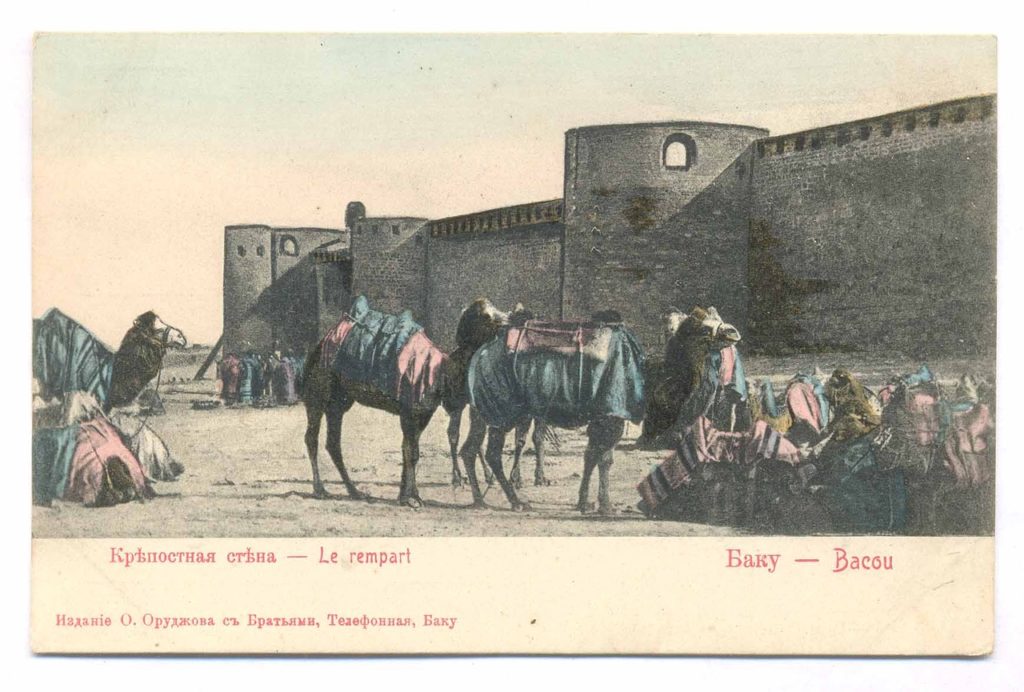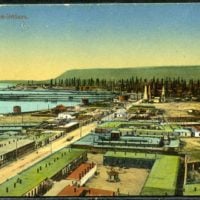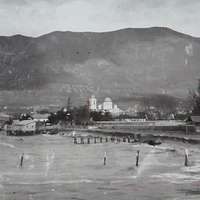
Related

Old Baku View Poscard., Russian Empire, 19th century

Дед Мороз С-Рождеством - Russian postcard. Public domain image.

Пристань в Таганроге - Russian postcard. Public domain image.

Old Baku. City Garden Postcard.

Baku. Bibi Heybat. Post card., Russian Empire, 19th century

Gelendzhik bay, Russia. 1900s postcard.

Post card. Baku., Russian Empire, 19th century

Old Baku. Khan Palace. Color postcard.

Old Baku. Shikhovo (Bibi Eibat).
Old Baku. Postcard - Russian postcard. Public domain image.
Summary
Old Baku. Fortress Towers and Wall.
From the Middle Ages, Baku was a part of the historical area of Shirvan and the state of Shirvanshahs. In the 12th century, Baku was surrounded by a two-rowed fortress wall and a moat. The maiden tower also entered the city's defense system. Various goods were exported from Baku to the Golden Horde, Russian principalities, Iran and Central Asia. In the XV century, the complex of the Shirvanshahs palace was built. In 1501, Shah Ismail took possession of the entire Shirvan, and Baku became part of the Safavid state. In 1578, the Ottoman army captured Baku. In 1607 the city again passed under the authority of the Safavids. In 1806 the Russian army led by Pavel Tsitsianov approached Baku, Tsitsianov was killed by the order of the ruler. On October 3 of the same year, Russian troops captured Baku, and Huseyn Kuli fled to Persia. Khanate was abolished and Baku became the center of the newly formed Baku province. In 1847, an oil well was drilled mechanically at the Bibi-Eybat deposit for the first time in the world. The industrial development of oil fields caused Baku's rapid growth, and it became an example of a rapidly growing European city. In 1859, Vasily Kokorev built the first Russian kerosene plant in Surakhani near Baku. In 1861, on the island of Pirallahi, the Tiflis pharmacist Witte built a paraffin plant. At this plant, paraffin wax, paraffin candles and paraffin oil were produced from oil. The foreman Javad Melikov built a kerosene plant in his own project in 1863. In 1871, the first well was drilled and commissioned in Balakhany with the help of a drilling rig. The influx of foreign capital began in Baku, the offices of the Rothschilds, Nobels and other businessmen were opened. In addition to the oil industry, weaving was developing, mechanical factories, tobacco factories, mills, manufacturing enterprises, etc. were opened. In 1878, the Baku City Duma was opened in the city. On May 8, 1883, the Baku-Tbilisi railway was launched. In 1899, a rival was opened, a steam fleet appeared in the Baku port. Many migrants - Russians, Jews, Germans, Armenians, Azerbaijanis (both from Russia and Persia) came to the city, etc. The cultural boom blossomed with the oil boom, theaters opened, the opera house building was built. Baku became known as the "Paris of the Caucasus". While no national group constituted an absolute majority, the main nationalities of the city were Azerbaijanis (then called Azerbaijani Tatars or Persians) and Armenians. Since the XVII century in Baku, there was a large Armenian community. Armenians inhabited entire streets and engaged in active trade. The bulk of the workers were Azerbaijani, although there were many merchants and owners of oil fields among them; while in the hands of the Armenians most of the trade and many oil trades were concentrated. Between these groups four times (in February and August 1905, in March and September 1918) there was a bloody massacres. Со средних веков Баку находился в исторической области Ширван и государства Ширваншахов. В XII веке Баку был окружен двухрядной крепостной стеной и рвом. Девичья башня также вошла в систему защиты города. Из Баку вывозились различные товары в Золотую Орду, русские княжества, Иран и Среднюю Азию. В XV веке был создан комплекс дворца Ширваншахов. В 1501 году Шах Исмаил овладел всем Ширваном, и Баку стал частью Сефевидского государства. В 1578 году Османская армия захватила Баку. В 1607 году город снова перешёл под власть Сефевидов. В 1806 русская армия под предводительством Павла Цицианова подошла к Баку, Цицианов был убит по приказу правителя. 3 октября того же года российские войска захватили Баку, а Гусейн Кули бежал в Персию. Ханство было упразднено и Баку стал центром вновь образованной Бакинской провинции. В 1847 году на Биби-Эйбатском месторождении впервые в мире механическим путём была пробурена нефтяная скважина. Промышленная разработка нефтяных месторождений стала причиной бурного роста Баку, и он стал образцом быстро растущего европейского города. В 1859 году Василий Кокорев построил в Сураханах под Баку первый в России керосиновый завод. В 1861 году на острове Пираллахи тифлисский фармацевт Витте построил парафиновый завод. На этом заводе из нефти изготовляли парафин, парафиновые свечи и парафиновое масло. Предниматель Джавад Меликов в 1863 году по собственному проекту построил керосиновый завод. В 1871 году в Балаханах с помощью бурильной установки была пробурена и сдана в эксплуатацию первая скважина. В Баку начался приток иностранного капитала, открылись офисы Ротшильдов, Нобелей и других предпринимателей. Помимо нефтяной промышленности развивалось ткацкое производство, открывались механические заводы, табачные фабрики, мельницы, обрабатывающие предприятия и т. п. В 1878 году в городе была открыта Бакинская городская дума. 8 мая 1883 года была пущена железная дорога Баку-Тбилиси. В 1899 году открыли конку, в Бакинском порту появился паровой флот. В город съехалось много мигрантов — русских, евреев, немцев, армян, азербайджанцев (как из России, так и из Персии) и т. д. С нефтяным бумом расцвела культурная жизнь, открылись театры, было построено здание оперного театра. Баку стал известен как «Париж Кавказа». При том, что ни одна национальная группа не составляла абсолютного большинства, основными национальностями города являлись азербайджанцы (которых тогда называли азербайджанскими татарами или персами) и армяне. С XVII века в Баку имелось имелась большая армянская община. Армяне заселяли целые улицы и занимались активной торговлей. Основную массу рабочих при этом составляли азербайджанцы, хотя и среди них было немало купцов и владельцев нефтяных промыслов; тогда как в руках армян была сосредоточена большая часть торговли и многие нефтяные промыслы. Между этими группами четыре раза (в феврале и августе 1905 г., в марте и сентябре 1918 г.) происходила кровопролитная резня.
- Old Baku. Postcard - PICRYL
- Old Baku. Postcard - Russian postcard. Public domain image.
- 33 Старый баку Images: PICRYL - Public Domain Media Search ...
- 33 Старый баку Images - Romanov Empire - Империя Романовых
- 32 Мусульманский квартал Images: PICRYL - Collections
- 34 Muslim areas Images: PICRYL - Collections - GetArchive
- 33 Muslim areas Images - Romanov Empire - Империя Романовых
- Старый Баку - LiveJournal
- Старый Баку - LiveJournal
- 229 Баку, Russian empire Images
